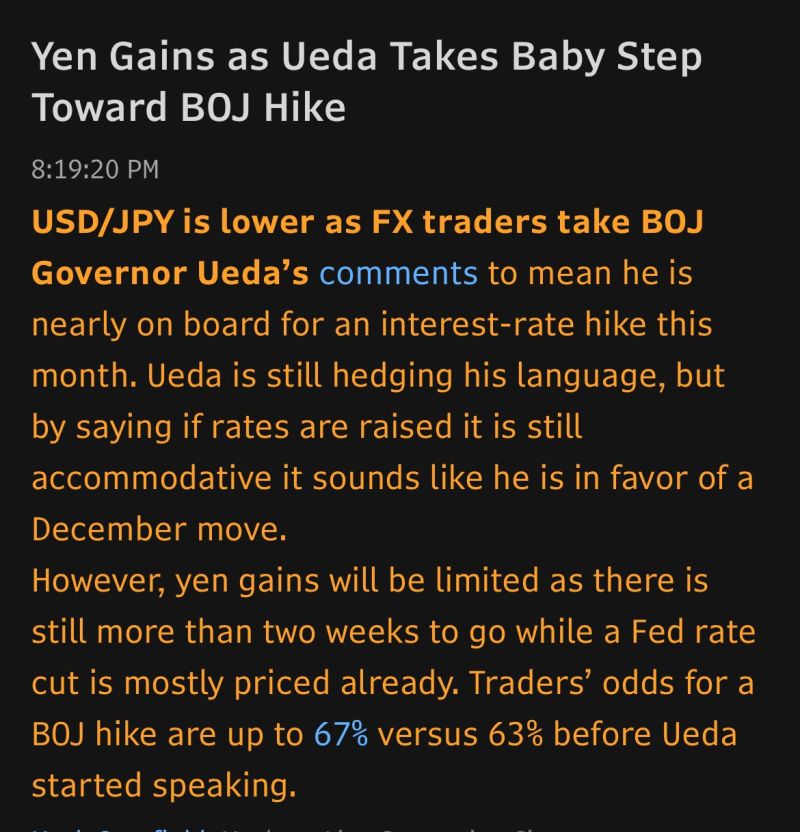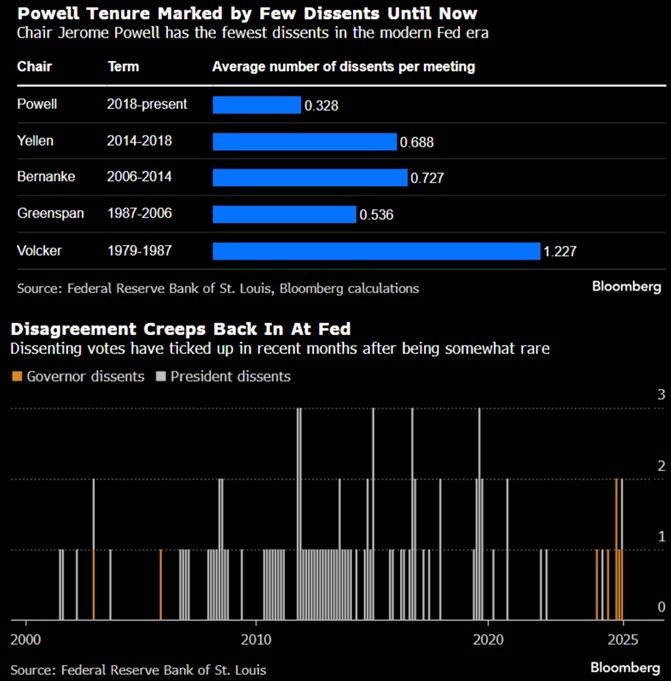Straight from the Desk
Syz the moment
Live feeds, charts, breaking stories, all day long.
- All
- equities
- United States
- Macroeconomics
- Food for Thoughts
- markets
- Central banks
- Fixed Income
- bitcoin
- Asia
- europe
- investing
- technical analysis
- geopolitics
- gold
- Crypto
- AI
- Commodities
- Technology
- nvidia
- ETF
- earnings
- Forex
- china
- Real Estate
- banking
- oil
- Volatility
- energy
- magnificent-7
- apple
- Alternatives
- emerging-markets
- switzerland
- tesla
- United Kingdom
- Middle East
- assetmanagement
- amazon
- russia
- ethereum
- microsoft
- ESG
- meta
- Industrial-production
- bankruptcy
- Healthcare
- Turkey
- Global Markets Outlook
- africa
- Market Outlook
- brics
- performance
Central banks have completely messed up market messaging.
First Fed's schziophrenic communications sent Dec rate cut odds from 80% to 30% to 100%, and now the BOJ just send Dec rate hike odds to 80% from 20% ten days ago! Source: zerohedge
This might force the hand of the Fed...
Powell may have floated the idea of a pause, but the cooling U.S. labor market tells a different story — and it’s opening the door to lower policy rates. Here’s the twist: Inflation is holding around 3.0%, dipped to 2.3%, and is averaging 2.7% for the year. GDP? Still strong. Demographics? Warping the job market. And yet… rate cuts are coming. Why? Because the other half of the Fed’s mandate is screaming for it. Lower rates conveniently support: Debt sustainability Financial-sector stability Liquidity across the system Central banks want lower rates — and their messaging shows it. That’s why we’re hearing nonstop about financial-sector risks, bond-market volatility, and liquidity needs… and far less about headline inflation.
Fed Reserve just pumped $13.5 Billion into the U.S. Banking System through overnight repos.
This is the 2nd largest liquidity injection since Covid and surpasses even the peak of the Dot Com Bubble Source. Barchart
🔥 Big Shift Today: The Fed Just Ended QT - What This Means For Overall Liquidity according to Goldman 🔥
After months of draining liquidity and a one-month delay that tightened markets, the Fed’s quantitative tightening officially ends today. Here’s what Wall Street is watching: 💧 Reserves Are Scraping Bottom Fed reserves hit a low in October, but should end 2025 around $2.9T - still uncomfortably close to “not enough.” Repo markets have already shown stress, with Standing Repo Facility usage hitting its 2nd-highest level since COVID. 🏦 Goldman’s Call: QT Ends, Balance Sheet Growth Returns Fast Goldman expects the Fed to start buying ~$20B/month in T-bills starting Jan 2026, plus reinvesting MBS runoff - together adding ~$40B/month back into the system. Reserves could climb back above $3T by late 2026. 💣 Why the Pivot? Liquidity Is Too Tight Repo rates (TGCR, SOFR) are trading well above where they “should” be. Funding markets keep flashing red. The Fed is quietly preparing to reflood the pipes. 📈 Treasury Supply Stays Heavy - But the Fed Becomes a Buyer Again With massive deficits ahead, Treasury issuance remains huge. But thanks to the shift in policy: Fed is expected to absorb ~$480B of next year’s T-bill issuance Non-Fed buyers only take ~$390B — the lowest since 2023 🍃 But There’s a Catch… The Fed will let $2T of MBS roll off, pushing a wave of mortgage-backed supply into markets. That means: ➡️ More pressure on housing and mortgage rates ➡️ A slow-motion shift from MBS → Treasuries in the system ⚠️ Bottom Line: QT ends today, but the liquidity story is far from over. Funding markets are strained, repo is volatile, MBS supply is surging - and the Fed may be forced to restart balance sheet expansion faster than anyone expected. The next big test? April tax season. If liquidity cracks again, the Fed’s “reserve management purchases” may turn into something much bigger. Source: Goldman Sachs, zerohedge
So what's going on in markets this morning? Why are Cryptos tumbling again?
A ris-off signal to start December? Well, it seems that the spike in Japanese bonds yields is the culprit... Indeed, Japanese bonds are puking on renewed expectations of rate hike, as the 2Yr JGB yield is above 1% for the first time since 2008. The yen is firming and the Nikkei 225 index is tumbling. And since nowadays Bitcoin always correlates with anything that's down, we have a 5% dump in Bitcoin in Asian trading to $85k.... In the middle of Asian session, BoJ Governor Ueda said he was consider the "pros and cons" of raising interest rates at the BoJ's December and idea that the market got hold of last week as the odds of a BoJ Dec rate hike increased from 30% to 50%. Source: Bloomberg, zerohedge
As a remainder, The FED ends QT tomorrow !
For years, they've been pulling money out of the system Tomorrow, that drain stops... Source: @PaulGoldEagle
Fed Rate-cut odds for December are on the rise...
Hopes of another rate cut in December were initially boosted by Fed's Williams dovish comments on Friday and then encouraged by Goldman over the weekend. Yesterday, San Francisco Fed's Daly added to the sudden dovish pivot (from the rampant hawkish pivot mid-last week): "On the labor market, I don't feel as confident we can get ahead of it," she said in an interview on Monday. "It's vulnerable enough now that the risk is it'll have a nonlinear change." An inflation breakout, by contrast, is a lower risk given how tariff-driven cost increases have been more muted than anticipated earlier this year, she said. Daly's comments pushed the odds of a December cut back above 80%... Source: zerohedge, Bloomberg
Powell tenure has been marked by few dissents... until now.
Dissenting votes have ticked up in recent months after being somewhat rare. Source: Bloomberg, RBC
Investing with intelligence
Our latest research, commentary and market outlooks









